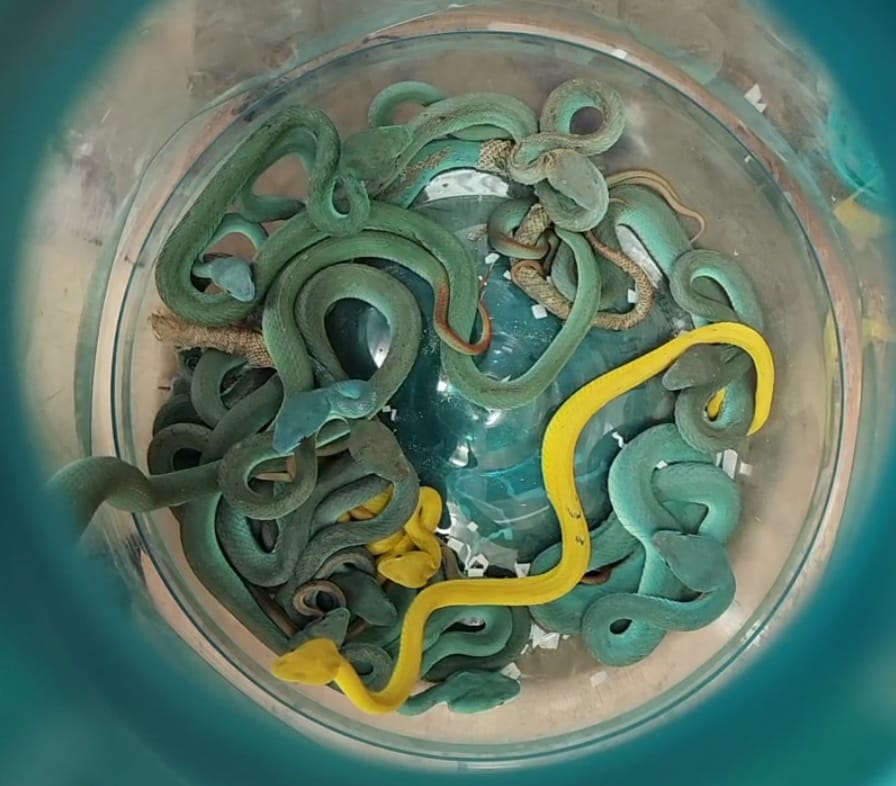Picture this: a bustling airport in Mumbai, where customs officials are on high alert, scrutinizing incoming passengers and luggage. Amid the usual hustle and bustle of travelers, one individual stands out—a man arriving from Thailand with a suitcase filled with a chilling surprise. Hidden within his checked baggage are not just any ordinary items but a collection of venomous snakes and small reptiles, carefully concealed from prying eyes.
The discovery shocks the authorities as they uncover 44 Indonesian pit vipers, known for their deadly venom, along with three spider-tailed horned vipers and five Asian leaf turtles. These creatures, exotic and dangerous, were being smuggled into the city, presumably for illicit trade or personal collection. The culprit, an Indian national, is swiftly apprehended, his sinister plans thwarted by vigilant customs agents.
This incident, although alarming, is not an isolated one. Mumbai customs officials regularly intercept contraband, ranging from drugs to gold, but the illicit trafficking of exotic wildlife is a recurring phenomenon. In recent months, the airport has witnessed a series of wildlife smuggling cases, each more audacious than the last.
In a daring attempt, a smuggler was caught with five siamang gibbons, rare apes native to Southeast Asia, cleverly hidden in plastic boxes inside a trolley bag. Another passenger tried to sneak in a package of 12 Japanese pond turtles and scorpion mud turtles, while two individuals were apprehended with Visayan hornbills, striking birds native to the Philippines. The list goes on, with instances of baby caiman crocodiles and other endangered species being trafficked through the airport’s gates.
A deeper dive into the global landscape of wildlife crime reveals a troubling reality. The United Nations Office on Drugs and Crime highlights the pervasive nature of this illicit trade, spanning 162 countries and territories and impacting over 4,000 plant and animal species. Among the most affected are rare orchids, succulents, reptiles, fish, birds, and mammals, many of which face the threat of extinction due to relentless poaching and trafficking.
The repercussions of wildlife trafficking extend far beyond the endangered species themselves. In Canada, diverse wildlife—from cougars to narwhals—face the risk of exploitation for financial gain. This not only disrupts ecosystems but also jeopardizes the delicate balance of nature, essential for mitigating climate change and supporting human well-being.
Moreover, the criminal networks involved in wildlife crime operate with sophisticated strategies, exploiting regulatory loopholes and engaging in corrupt practices that erode governance and the rule of law. These enterprises, entrenched in every aspect of the global trade chain, pose a formidable challenge to conservation efforts and sustainable biodiversity management.
As we confront the grim realities of wildlife trafficking, it becomes evident that protecting our planet’s natural heritage is not just a moral imperative but a crucial factor in safeguarding our own future. Preserving biodiversity is essential for ecosystem resilience, sustainable livelihoods, and the well-being of present and future generations.
The snakes on a plane may have been intercepted, but the larger battle against wildlife crime rages on. It is a battle that requires collective vigilance, stringent enforcement of laws, and a shift in societal attitudes towards valuing and respecting the diverse life forms with which we share this planet. Only through concerted efforts and unwavering commitment can we hope to secure a harmonious coexistence between humans and the magnificent wildlife that enriches our world.









Leave feedback about this